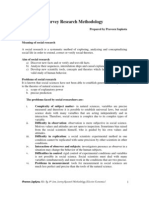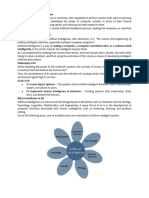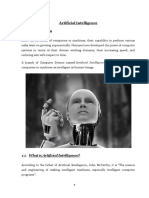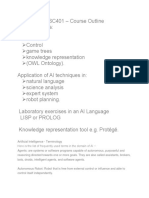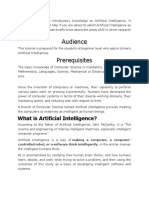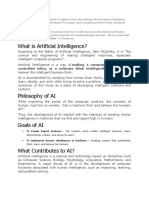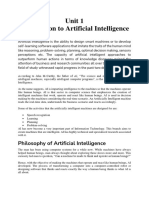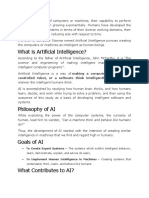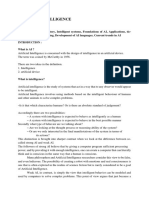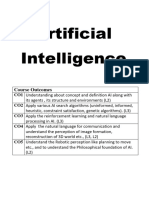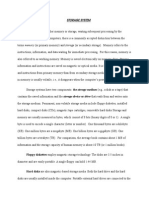Ai PDF
Ai PDF
Uploaded by
sai ramCopyright:
Available Formats
Ai PDF
Ai PDF
Uploaded by
sai ramOriginal Title
Copyright
Available Formats
Share this document
Did you find this document useful?
Is this content inappropriate?
Copyright:
Available Formats
Ai PDF
Ai PDF
Uploaded by
sai ramCopyright:
Available Formats
ARITIFICIAL INTELLIGENCE
1. INTRODUCTION TO AI
According to the father of Artificial Intelligence John McCarthy, it is “The science
and engineering of making intelligent machines, especially intelligent computer programs”.
Artificial Intelligence is a way of making a computer, a computer-controlled robot, or a
software think intelligently, in the similar manner the intelligent humans think.
AI is accomplished by studying how human brain thinks, and how humans learn, decide,
and work while trying to solve a problem, and then using the outcomes of this study as a
basis of developing intelligent software and systems.
1.1. Philosophy of AI
While exploiting the power of the computer systems, the curiosity of human, lead him
to wonder, “Can a machine think and behave like humans do?”
Thus, the development of AI started with the intention of creating similar intelligence
in machines that we find and regard high in humans.
1.2. Goals of AI
To Create Expert Systems: The systems which exhibit intelligent behavior,
learn, demonstrate, explain, and advice its users.
To Implement Human Intelligence in Machines: Creating systems that
understand, think, learn, and behave like human
1.3. What Contributes to AI?
Artificial intelligence is a science and technology based on disciplines such as computer
Science, Biology, Psychology, Mathematics, and Engineering. A major thrust of AI is in
the development of computer functions associated with human intelligence, such as
reasoning, learning, and problem solving.
Out of the following areas, one or multiple areas can contribute to build an intelligent system
Programming Without and With AI
The Programming without and with AI is different in following ways:
Dept of CSE Page 1
ARITIFICIAL INTELLIGENCE
Programming Without AI Programming With AI
A computer program without AI can
A computer program with AI can answer the
answer the specific questions it is meant to generic questions it is meant to solve.
solve.
AI programs can absorb new modifications by
Modification in the program leads to putting highly independent pieces of
change in its structure. information together. Hence you can modify
even a minute piece of information of program
without affecting its structure.
Modification is not quick and easy. It may
Quick and Easy program modification.
lead to affecting the program adversely.
1.4. What is AI Technique?
In the real world, the knowledge has some unwelcomed properties:
Its volume is huge, next to unimaginable.
It is not well-organized or well-formatted.
It keeps changing constantly.
AI Technique is a manner to organize and use the knowledge efficiently in such a way that:
It should be perceivable by the people who provide it.
It should be easily modifiable to correct errors.
It should be useful in many situations though it is incomplete or inaccurate.
AI techniques elevate the speed of execution of the complex program it is equipped with.
1.5. Applications ofAI
AI has been dominant in various fields such as:
Gaming
AI plays crucial role in strategic games such as chess, poker, tic-tac-toe, etc., where
machine can think of large number of possible positions based on heuristic knowledges.
Natural Language Processing
It is possible to interact with the computer that understands natural language spoken by
humans.
Expert Systems
There are some applications which integrate machine, software, and special
information to impart reasoning and advising. They provide explanation and advice to the
users.
Dept of CSE Page 2
ARITIFICIAL INTELLIGENCE
Vision Systems
These systems understand, interpret, and comprehend visual input on the computer. For
example,
o A spying aeroplane takes photographs which are used to figure out spatial
information or map of the areas.
o Doctors use clinical expert system to diagnose the patient.
o Police use computer software that can recognize the face of criminal with the
stored portrait made by forensic artist.
Speech Recognition
Some intelligent systems are capable of hearing and comprehending the language in
terms of sentences and their meanings while a human talks to it. It can handle different
accents, slang words, noise in the background, change in human’s noise due to cold, etc.
Handwriting Recognition
The handwriting recognition software reads the text written on paper by a pen or on
screen by a stylus. It can recognize the shapes of the letters and convert it into editable text.
Intelligent Robots
Robots are able to perform the tasks given by a human. They have sensors to detect
physical data from the real world such as light, heat, temperature, movement, sound,
bump, and pressure. They have efficient processors, multiple sensors and huge
memory, to exhibit intelligence. In addition, they are capable of learning from their
mistakes and they can adapt to the new environment.
Dept of CSE Page 3
ARITIFICIAL INTELLIGENCE
2. HISTORY OF ARTIFICIAL INTELLIGENCE
Artificial Intelligence is not a new word and not a new technology for researchers. This
technology is much older than you would imagine. Even there are the myths of Mechanical men
in Ancient Greek and Egyptian Myths. Following are some milestones in the history of AI which
defines the journey from the AI generation to till date development.
Maturation of Artificial Intelligence (1943-1952)
o Year 1943: The first work which is now recognized as AI was done by Warren
McCulloch and Walter pits in 1943. They proposed a model of artificial neurons.
o Year 1949: Donald Hebb demonstrated an updating rule for modifying the connection
strength between neurons. His rule is now called Hebbian learning.
o Year 1950: The Alan Turing who was an English mathematician and pioneered Machine
learning in 1950. Alan Turing publishes "Computing Machinery and Intelligence" in
which he proposed a test. The test can check the machine's ability to exhibit intelligent
behavior equivalent to human intelligence, called a Turing test.
The birth of Artificial Intelligence (1952-1956)
o Year 1955: An Allen Newell and Herbert A. Simon created the "first artificial
intelligence program"Which was named as "Logic Theorist". This program had proved
Dept of CSE Page 4
ARITIFICIAL INTELLIGENCE
38 of 52 Mathematics theorems, and find new and more elegant proofs for some
theorems.
o Year 1956: The word "Artificial Intelligence" first adopted by American Computer
scientist John McCarthy at the Dartmouth Conference. For the first time, AI coined as an
academic field.
At that time high-level computer languages such as FORTRAN, LISP, or COBOL were
invented. And the enthusiasm for AI was very high at that time.
The golden years-Early enthusiasm (1956-1974)
o Year 1966: The researchers emphasized developing algorithms which can solve
mathematical problems. Joseph Weizenbaum created the first chatbot in 1966, which was
named as ELIZA.
o Year 1972: The first intelligent humanoid robot was built in Japan which was named as
WABOT-1.
The first AI winter (1974-1980)
o The duration between years 1974 to 1980 was the first AI winter duration. AI winter
refers to the time period where computer scientist dealt with a severe shortage of funding
from government for AI researches.
o During AI winters, an interest of publicity on artificial intelligence was decreased.
A boom of AI (1980-1987)
o Year 1980: After AI winter duration, AI came back with "Expert System". Expert
systems were programmed that emulate the decision-making ability of a human expert.
o In the Year 1980, the first national conference of the American Association of Artificial
Intelligence was held at Stanford University.
The second AI winter (1987-1993)
o The duration between the years 1987 to 1993 was the second AI Winter duration.
o Again Investors and government stopped in funding for AI research as due to high cost
but not efficient result. The expert system such as XCON was very cost effective.
The emergence of intelligent agents (1993-2011)
o Year 1997: In the year 1997, IBM Deep Blue beats world chess champion, Gary
Kasparov, and became the first computer to beat a world chess champion.
o Year 2002: for the first time, AI entered the home in the form of Roomba, a vacuum
cleaner.
Dept of CSE Page 5
ARITIFICIAL INTELLIGENCE
o Year 2006: AI came in the Business world till the year 2006. Companies like Facebook,
Twitter, and Netflix also started using AI.
Deep learning, big data and artificial general intelligence (2011-present)
o Year 2011: In the year 2011, IBM's Watson won jeopardy, a quiz show, where it had to
solve the complex questions as well as riddles. Watson had proved that it could
understand natural language and can solve tricky questions quickly.
o Year 2012: Google has launched an Android app feature "Google now", which was able
to provide information to the user as a prediction.
o Year 2014: In the year 2014, Chatbot "Eugene Goostman" won a competition in the
infamous "Turing test."
o Year 2018: The "Project Debater" from IBM debated on complex topics with two master
debaters and also performed extremely well.
o Google has demonstrated an AI program "Duplex" which was a virtual assistant and
which had taken hairdresser appointment on call, and lady on other side didn't notice that
she was talking with the machine.
Dept of CSE Page 6
ARITIFICIAL INTELLIGENCE
3. WHAT IS ARTIFICIAL INTELLIGENCE?
Artificial intelligence (AI) is wide-ranging branch of computer science concerned with building
smart machines capable of performing tasks that typically require human intelligence. AI is an
interdisciplinary science with multiple approaches, but advancements in machine learning and
deep learning are creating a paradigm shift in virtually every sector of the tech
industry. Artificial intelligence is the development of computer system that are capable of
performing tasks that normall require human intelligence , such as decision making , object
detection, sloving complex problems and soon
3.1. HOW DOES ARTIFICIAL INTELLIGENCE WORK?
Can machines think? — Alan Turing, 1950
Less than a decade after breaking the Nazi encryption machine Enigma and helping the Allied
Forces win World War II, mathematician Alan Turing changed history a second time with a
simple question: "Can machines think?"
Turing's paper "Computing Machinery and Intelligence" (1950), and it's subsequent Turing Test,
established the fundamental goal and vision of artificial intelligence.
At it's core, AI is the branch of computer science that aims to answer Turing's question in the
affirmative. It is the endeavor to replicate or simulate human intelligence in machines.
The expansive goal of artificial intelligence has given rise to many questions and debates. So
much so, that no singular definition of the field is universally accepted.
The major limitation in defining AI as simply "building machines that are intelligent" is that it
doesn't actually explain what artificial intelligence is? What makes a machine intelligent?
In their groundbreaking textbook Artificial Intelligence: A Modern Approach, authors Stuart
Russell and Peter Norvig approach the question by unifying their work around the theme of
Dept of CSE Page 7
ARITIFICIAL INTELLIGENCE
intelligent agents in machines. With this in mind, AI is "the study of agents that receive percepts
from the environment and perform actions." (Russel and Norvig viii)
Norvig and Russell go on to explore four different approaches that have historically defined the
field of AI:
1. Thinking humanly
2. Thinking rationally
3. Acting humanly
4. Acting rationally
The first two ideas concern thought processes and reasoning, while the others deal with behavior.
Norvig and Russell focus particularly on rational agents that act to achieve the best outcome,
noting "all the skills needed for the Turing Test also allow an agent to act rationally." (Russel
and Norvig 4).
Patrick Winston, the Ford professor of artificial intelligence and computer science at
MIT, defines AI as "algorithms enabled by constraints, exposed by representations that support
models targeted at loops that tie thinking, perception and action together."
While these definitions may seem abstract to the average person, they help focus the field as an
area of computer science and provide a blueprint for infusing machines and programs with
machine learning and other subsets of artificial intelligence.
While addressing a crowd at the Japan AI Experience in 2017, DataRobot CEO Jeremy Achin
began his speech by offering the following definition of how AI is used today:
"AI is a computer system able to perform tasks that ordinarily require human intelligence...
Many of these artificial intelligence systems are powered by machine learning, some of them are
powered by deep learning and some of them are powered by very boring things like rules."
Dept of CSE Page 8
ARITIFICIAL INTELLIGENCE
4. STAGES OF ARTIFICIAL INTELLIGENCE
In modern science, Artificial Intelligence has three stages. They are as follows:
1) Artificial Narrow Intelligence (ANI)
2) Artificial General Intelligence (AGI)
3) Artificial Super Intelligence (ASI)
4.1. Artificial Narrow Intelligence (ANI)
When Artificial Intelligence system is programmed in such a way that it performs a set of
instructions only for the specified data, then it is termed as Artificial Narrow Intelligence.
Artificial Narrow Intelligence doesn’t mean a dumb program; it is just that it is made for a
specific set of tasks.
Let’s consider an example of a Virtual Assistant such as Siri, Alexa, and Google Assistant. All
these Virtual Assistants are programmed in such a way that they can perform several tasks, but
these tasks are limited only to their respective devices, i.e., smartphones, tablets, etc. Suppose, if
you ask Siri to make a call to your friend, it will make the call using the same iPhone, it won’t
use your landline, because, it simply can’t do it.So, I think we got the basic idea of Artificial
Narrow Intelligence, now let’s get in brief with Artificial General Intelligence.
4.2. Artificial General Intelligence (AGI)
When Artificial Intelligence system is programmed in such a way that it can totally mimic
human intelligence and behavior, then it is termed as Artificial General Intelligence. Some
researchers refer it to as “Strong AI” and “Full AI”. In simple words, it is the Artificial
Intelligence System that can totally work and take decisions similar to human beings.
In the present industry, no such system is available, but researchers and scientists believe that in
a few years, we will interact with such systems.
4.3. Artificial Super Intelligence (ASI)
When Artificial Intelligence system is programmed in such a way that its decision-making ability
and the ability to mimic human intelligence is way better than human, then it is termed as Super
Intelligence. In simple words, it is the system which surpasses human abilities.
Dept of CSE Page 9
ARITIFICIAL INTELLIGENCE
In the present industry, this type of system is available only in the form of fictions. For example,
in Avengers: Endgame (Movie), the Jarvis was able to make decisions better than humans so that
it can be considered as Artificial Super Intelligence system. Some people think that the
emergence of this system will lead to the bane of human life. However, in order to program this
system, it will take decades or probably, centuries.
I think, now you are well aware of Artificial Intelligence and its stages, and also how they differ
from each other. If you are interested in learning Artificial Intelligence and standing out of the
crowd,
Dept of CSE Page 10
ARITIFICIAL INTELLIGENCE
5. TYPES OF ARTIFICIAL INTELLIGENCE
There are four types of artificial intelligence: reactive machines, limited memory, theory of mind
and self-awareness.
5.1. REACTIVE MACHINES
The most basic types of AI systems are purely reactive, and have the ability neither to form
memories nor to use past experiences to inform current decisions. Deep Blue, IBM’s chess-
playing supercomputer, which beat international grandmaster Garry Kasparov in the late 1990s,
is the perfect example of this type of machine.
Deep Blue can identify the pieces on a chess board and know how each moves. It can make
predictions about what moves might be next for it and its opponent. And it can choose the most
optimal moves from among the possibilities.
But it doesn’t have any concept of the past, nor any memory of what has happened before. Apart
from a rarely used chess-specific rule against repeating the same move three times, Deep Blue
ignores everything before the present moment. All it does is look at the pieces on the chess board
as it stands right now, and choose from possible next moves.
This type of intelligence involves the computer perceiving the world directly and acting on what
it sees. It doesn’t rely on an internal concept of the world. In a seminal paper, AI researcher
Rodney Brooks argued that we should only build machines like this. His main reason was that
people are not very good at programming accurate simulated worlds for computers to use, what
is called in AI scholarship a “representation” of the world.
Dept of CSE Page 11
ARITIFICIAL INTELLIGENCE
The current intelligent machines we marvel at either have no such concept of the world, or have
a very limited and specialized one for its particular duties. The innovation in Deep Blue’s
design was not to broaden the range of possible movies the computer considered. Rather, the
developers found a way to narrow its view, to stop pursuing some potential future moves, based
on how it rated their outcome. Without this ability, Deep Blue would have needed to be an even
more powerful computer to actually beat Kasparov.
Similarly, Google’s AlphaGo, which has beaten top human Go experts, can’t evaluate all
potential future moves either. Its analysis method is more sophisticated than Deep Blue’s, using
a neural network to evaluate game developments.
These methods do improve the ability of AI systems to play specific games better, but they can’t
be easily changed or applied to other situations. These computerized imaginations have no
concept of the wider world – meaning they can’t function beyond the specific tasks they’re
assigned and are easily fooled.
They can’t interactively participate in the world, the way we imagine AI systems one day might.
Instead, these machines will behave exactly the same way every time they encounter the same
situation. This can be very good for ensuring an AI system is trustworthy: You want your
autonomous car to be a
reliable driver. But it’s bad if we want machines to truly engage with, and respond to, the world.
These simplest AI systems won’t ever be bored, or interested, or sad.
5.2. LIMITED MEMORY
This Type II class contains machines can look into the past. Self-driving cars do some of this
already. For example, they observe other cars’ speed and direction. That can’t be done in a just
one moment, but rather requires identifying specific objects and monitoring them over time.
These observations are added to the self-driving cars’ preprogrammed representations of the
world, which also include lane markings, traffic lights and other important elements, like curves
in the road. They’re included when the car decides when to change lanes, to avoid cutting off
another driver or being hit by a nearby car.
But these simple pieces of information about the past are only transient. They aren’t saved as
part of the car’s library of experience it can learn from, the way human drivers compile
experience over years behind the wheel.
So how can we build AI systems that build full representations, remember their experiences and
learn how to handle new situations? Brooks was right in that it is very difficult to do this. My
own research into methods inspired by Darwinian evolution can start to make up for human
shortcomings by letting the machines build their own representations.
5.3. THEORY OF MIND
We might stop here, and call this point the important divide between the machines we have and
the machines we will build in the future. However, it is better to be more specific to discuss the
types of representations machines need to form, and what they need to be about.
Dept of CSE Page 12
ARITIFICIAL INTELLIGENCE
Machines in the next, more advanced, class not only form representations about the world, but
also about other agents or entities in the world. In psychology, this is called “theory of mind” –
the understanding that people, creatures and objects in the world can have thoughts and emotions
that affect their own behavior.
This is crucial to how we humans formed societies, because they allowed us to have social
interactions. Without understanding each other’s motives and intentions, and without taking into
account what somebody else knows either about me or the environment, working together is at
best difficult, at worst impossible.
If AI systems are indeed ever to walk among us, they’ll have to be able to understand that each
of us has thoughts and feelings and expectations for how we’ll be treated. And they’ll have to
adjust their behavior accordingly.
5.4. SELF-AWARENESS
The final step of AI development is to build systems that can form representations about
themselves. Ultimately, we AI researchers will have to not only understand consciousness, but
build machines that have it.
This is, in a sense, an extension of the “theory of mind” possessed by Type III artificial
intelligences. Consciousness is also called “self-awareness” for a reason. (“I want that item” is a
very different statement from “I know I want that item.”) Conscious beings are aware of
themselves, know about their internal states, and are able to predict feelings of others. We
assume someone honking behind us in traffic is angry or impatient, because that’s how we feel
when we honk at others. Without a theory of mind, we could not make those sorts of inferences.
While we are probably far from creating machines that are self-aware, we should focus our
efforts toward understanding memory, learning and the ability to base decisions on past
experiences. This is an important step to understand human intelligence on its own. And it is
crucial if we want to design or evolve machines that are more than exceptional at classifying
what they see in front of them.
Dept of CSE Page 13
ARITIFICIAL INTELLIGENCE
6. CHALLENGES FOR AI:
1. Computing is not that Advanced
Machine Learning and deep learning techniques that seem most beneficial require a series of
calculations to made very quickly ( in microseconds or nanoseconds or slower than that.It clearly
indicates that these AI techniques utilize a lot of processing power.AI has been in the expert
discussion for a long time. And always it came out that there is not enough power to implement
these AI techniques.
Cloud computing and massively parallel processing systems have created hope to implementation
of these techniques for short term, but as data volumes go up, and deep learning moves towards
automated creation of increasingly complex algorithms, cloud computing would not help!
2. Fewer people support
AI implementation does not have enough use cases in the market. And without it, no organization
would be interested to invest money in AI-based projects. It clearly means that there have been
comparatively few organizations interested in putting money into the development of AI-based
products. Moreover, there are not enough people who can make other businesses understand the
vision of machine powered progress in the world. In simple words, we can say that there are not
enough people who know how to operate machines which think and learn by themselves.
For a remedy to this problem, a mild cure is a citizen data scientist. But this is also not a
permanent or real solution. Another alternative is a shift towards offering platforms and tools that
permit AI driven work “as a service”. Rather than starting everything from scratch, organizations
are able to take ready-made solutions and plug in their own data.
3. Creating Trust
The problem with AI is that it is like a black box for people. People don’t feel comfortable when
they don’t understand how the decision was made. For instance, banks use simple algorithms that
are based on linear maths and it is easy to explain the algorithm and how they reached from input
to output.
Hence, somewhere AI has not been able to create trust among people. And the only solution that
seems to this problem is to let people see that this technology really works. However, the reality is
somewhat different. And it shows that there is a lot of opportunities to make things better by
Dept of CSE Page 14
ARITIFICIAL INTELLIGENCE
having predictions that are more accurate. This raises problems of government overstep. Suppose,
a part of the regulation tells that citizens may have the right to ask an explanation for decisions
that are made about them with the help of Artificial Intelligence.
4. One Track Minds
A big problem that should be taken into account is that most of the AI implementations are highly
specialized. We also call specialized AI as “Applied AI”. And it is built just to perform a single
task and keep learning to become better and better at it. The process that it follows is to look at the
inputs given and results produced. It looks at the best result produced and notes down those input
values. Generalized AI is different and can jump to any task similar to a human being. However,
it is yet to come in the future. It simply means that AIs need to be trained just to make sure that
their solutions do not cause other issues. Specifically, all those areas that are beyond those which
they designed to consider.
5. Provability
Organizations working on AI-based products cannot demonstrate clearly about their vision and
what they have achieved with the help of AI techniques. People are doubtful about this
technology that how it takes decisions and whether all its decisions are perfect or not Moreover,
such kind of confusion has surrounded the minds of people. And ultimately, a probability which is
the mathematical uncertainty behind AI predictions still remain as an unclear region for
organizations. They cannot prove that the AI system’s decision-making process is fine. And its
only remedy can lie in making AI explainable, provable and transparent. Organizations should
implement explainable AI.
6. Data Privacy and security
Most of the AI applications are based on massive volumes of data to learn and make intelligent
decisions. Machine learning systems depend on the data which is often sensitive and personal in
nature. These systems learn from the data and improve themselves. Due to this systematic
learning, these ML systems can become prone to data breach and identity theft. European Union
has implemented the General Data Protection Regulation (GDPR) that makes sure the complete
protection of personal data. This step is taken after taking a look at increasing awareness in
customers regarding an increasing number of machine-made decisions. Moreover, there is a
unique method known as Federated learning that is aimed to disrupt the AI paradigm. This
Federated learning will encourage data scientists to create AI without affecting users’ data
security and confidentiality.
Dept of CSE Page 15
ARITIFICIAL INTELLIGENCE
7. Algorithm bias
A big problem with AI systems is that their level of goodness or badness depends on the much
data they are trained on. Bad data is often associated with, ethnic, communal, gender or racial
biases. Proprietary algorithms are used to find out things like who granted bail, whose loan is
sanctioned etc. If in case, a bias hidden in the algorithms which take crucial decisions goes
unrecognized, it could lead to unethical and unfair results. In future, such biases will be more
highlighted as many AI systems will continue to be trained to utilize bad data. Hence, the urgent
need in front of organizations working on AI is to train these systems with unbiased data and
create algorithms that can be easily explained. It is the fact that organizations have access to more
data in the present time than ever before. However, datasets that are applicable to AI applications
to learn are really rare. However, the most powerful AI machines are those that are trained on
supervised learning. This kind of training requires labeled data. Labeled data is organized to make
it understandable for machines to learn. One more thing about labeled data is that it has a limit. In
future automated creation of increasingly difficult algorithms will only worsen the problem. Still,
there is a ray of hope. As time is passing, organizations are investing in design methodologies and
focusing on how to create AI models learn despite the scarcity of labeled data.
Dept of CSE Page 16
ARITIFICIAL INTELLIGENCE
7. FUTURE OF ARTIFICIAL INTELLIGENCE
A lot of visionaries like Stephen Hawking, Steve Wozniak, Elon Musk and others have predicted
that AI could be dangerous because if machines started thinking better than humans, then where
would humans be?
We have the power to diffuse what we have created. What we need to know is where to draw the
line.
It’s overwhelming and exciting – but definitely not scary. In this article, we will discuss some
compelling opportunities in the field of AI that were unthinkable in the past.
Mr. Sundar Pichai, the CEO of Google once said that everything in Google is going to be AI
centered which could mean that AI will create numerous job opportunities that will require
creativity, critical thinking skills and much more.
Dept of CSE Page 17
ARITIFICIAL INTELLIGENCE
8. ADVANTAGES OF ARTIFICIAL INTELLIGENCE
1) Reduction in Human Error:
The phrase “human error” was born because humans make mistakes from time to time.
Computers, however, do not make these mistakes if they are programmed properly. With
Artificial intelligence, the decisions are taken from the previously gathered information applying a
certain set of algorithms. So errors are reduced and the chance of reaching accuracy with a greater
degree of precision is a possibility.
Example: In Weather Forecasting using AI they have reduced the majority of human error.
2) Takes risks instead of Humans:
This is one of the biggest advantages of Artificial intelligence. We can overcome many risky
limitations of humans by developing an AI Robot which in turn can do the risky things for us. Let
it be going to mars, defuse a bomb, explore the deepest parts of oceans, mining for coal and oil, it
can be used effectively in any kind of natural or man-made disasters.
Example: Have you heard about the Chernobyl nuclear power plant explosion in Ukraine? At
that time there were no AI-powered robots that can help us to minimize the effect of radiation by
controlling the fire in early stages, as any human went close to the core was dead in a matter of
minutes. They eventually poured sand and boron from helicopters from a mere distance. AI
Robots can be used in such situations where intervention can be hazardous.
3) Available 24x7:
An Average human will work for 4–6 hours a day excluding the breaks. Humans are built in such
a way to get some time out for refreshing themselves and get ready for a new day of work and
they even have weekly offed to stay intact with their work-life and personal life. But using AI we
can make machines work 24x7 without any breaks and they don’t even get bored, unlike humans.
Example: Educational Institutes and Helpline centers are getting many queries and issues which
can be handled effectively using AI.
Dept of CSE Page 18
ARITIFICIAL INTELLIGENCE
4) Helping in Repetitive Jobs:
In our day-to-day work, we will be performing many repetitive works like sending a thanking
mail, verifying certain documents for errors and many more things. Using artificial intelligence
we can productively automate these mundane tasks and can even remove “boring” tasks for
humans and free them up to be increasingly creative.
Example: In banks, we often see many verifications of documents to get a loan which is a
repetitive task for the owner of the bank. Using AI Cognitive Automation the owner can speed up
the process of verifying the documents by which both the customers and the owner will be
benefited.
5) Digital Assistance:
Some of the highly advanced organizations use digital assistants to interact with users which
saves the need for human resources. The digital assistants also used in many websites to provide
things that users want. We can chat with them about what we are looking for. Some chatbots are
designed in such a way that it’s become hard to determine that we’re chatting with a chatbot or a
human being.
Example: We all know that organizations have a customer support team that needs to clarify the
doubts and queries of the customers. Using AI the organizations can set up a Voice bot or Chatbot
which can help customers with all their queries. We can see many organizations already started
using them on their websites and mobile applications.
6) Faster Decisions:
Using AI alongside other technologies we can make machines take decisions faster than a human
and carry out actions quicker. While taking a decision human will analyze many factors both
emotionally and practically but AI-powered machine works on what it is programmed and
delivers the results in a faster way.
Example: We all have played Chess games in Windows. It is nearly impossible to beat CPU in
the hard mode because of the AI behind that game. It will take the best possible step in a very
short time according to the algorithms used behind it.
Dept of CSE Page 19
ARITIFICIAL INTELLIGENCE
7) Daily Applications:
Daily applications such as Apple’s Siri, Window’s Cortana, Google’s OK Google are frequently
used in our daily routine whether it is for searching a location, taking a selfie, making a phone
call, replying to a mail and many more.
Example: Around 20 years ago, when we are planning to go somewhere we used to ask a person
who already went there for the directions. But now all we have to do is say “OK Google where is
Visakhapatnam”. It will show you Visakhapatnam’s location on google map and the best path
between you and Visakhapatnam.
8) New Inventions:
AI is powering many inventions in almost every domain which will help humans solve the
majority of complex problems.
Example: Recently doctors can predict breast cancer in the woman at earlier stages using
advanced AI-based technologies.
Dept of CSE Page 20
ARITIFICIAL INTELLIGENCE
9. DISADVANTAGES OF ARTIFICIAL INTELLIGENCE
1) High Costs of Creation:
As AI is updating every day the hardware and software need to get updated with time to meet the
latest requirements. Machines need repairing and maintenance which need plenty of costs. It’ s
creation requires huge costs as they are very complex machines.
2) Making Humans Lazy:
AI is making humans lazy with its applications automating the majority of the work. Humans tend
to get addicted to these inventions which can cause a problem to future generations.
3) Unemployment:
As AI is replacing the majority of the repetitive tasks and other works with robots,human
interference is becoming less which will cause a major problem in the employment standards.
Every organization is looking to replace the minimum qualified individuals with AI robots which
can do similar work with more efficiency.
4) No Emotions:
There is no doubt that machines are much better when it comes to working efficiently but they
cannot replace the human connection that makes the team. Machines cannot develop a bond with
humans which is an essential attribute when comes to Team Management.
5) Lacking Out of Box Thinking:
Machines can perform only those tasks which they are designed or programmed to do, anything
out of that they tend to crash or give irrelevant outputs which could be a major backdrop.
Dept of CSE Page 21
ARITIFICIAL INTELLIGENCE
10. CONCLUSION
AI is at the centre of a new enterprise to build computational models of intelligence. The main
assumption is that intelligence (human or otherwise) can be represented in terms of symbol
structures and symbolic operations which can be programmed in a digital computer. There is
much debate as to whether such an appropriately programmed computer would be a mind, or
would merely simulate one, but AI researchers need not wait for the conclusion to that debate,
nor for the hypothetical computer that could model all of human intelligence. Aspects of
intelligent behaviour, such as solving problems, making inferences, learning, and understanding
language, have already been coded as computer programs, and within very limited domains, such
as identifying diseases of soybean plants, AI programs can outperform human experts. Now the
great challenge of AI is to find ways of representing the commonsense knowledge and
experience that enable people to carry out everyday activities such as holding a wide-ranging
conversation, or finding their way along a busy street. Conventional digital computers may be
capable of running such programs, or we may need to develop new machines that can support the
complexity of human thought.
Dept of CSE Page 22
ARITIFICIAL INTELLIGENCE
11. REFERENCE
1. Kumar, P.S.G. (2004) Information Technology: Applications. New Delhi: BRPC.
Pp 401-425
2. Nil’s, J.Nilson. (1998) Artificial Intelligence. New Delhi: Harcourt , 280-281
3. Patrick Henry Winston. (1999) Artificial Intelligence, Addison Wesley, New
Delhi: 10-12.
4. www.aaai.Org/AITOPICS
5. www. sstramel.blogspot.in/2009/09/artificial intelligence-advantages
6. www.wiki.org/Pattern Recognition
7. www.wikipedia.org/expertsystem
8. www.wikipedia.org/Robotics
9. https://en.wikipedia.org/wiki/Artificial_intelligence
Dept of CSE Page 23
You might also like
- Installations OMSI 2Document3 pagesInstallations OMSI 2KapputNo ratings yet
- Artificial Intelligence Lecture NoteDocument55 pagesArtificial Intelligence Lecture NoteAhmad Muhammad DandalaNo ratings yet
- Final MonographDocument61 pagesFinal Monographshams ur rehman50% (2)
- Survey Research Methodology: A Class Note ofDocument13 pagesSurvey Research Methodology: A Class Note ofPraveen SapkotaNo ratings yet
- The Semantic Web: Vineeta, 8PGC18, M.Tech (III Semester)Document24 pagesThe Semantic Web: Vineeta, 8PGC18, M.Tech (III Semester)vini_upmanyuNo ratings yet
- Lecture 4 - Freedom of Expression and Intellectual PropertyDocument76 pagesLecture 4 - Freedom of Expression and Intellectual PropertyPAUL LESTER HABLANo ratings yet
- 11) SSSEA v. CADocument1 page11) SSSEA v. CAMonicaCelineCaroNo ratings yet
- Webdesign Development SyllabusDocument14 pagesWebdesign Development SyllabusSUBBA RAO DAGGUBATINo ratings yet
- Corporate Finance ReportDocument45 pagesCorporate Finance ReportShahroze Khan AlizaiNo ratings yet
- Ai PDFDocument23 pagesAi PDFsai ramNo ratings yet
- A.I. Module 1 Lesson 1Document29 pagesA.I. Module 1 Lesson 1Ken Ne DyNo ratings yet
- Lect 01Document4 pagesLect 01Govind TripathiNo ratings yet
- AI Unit 1Document44 pagesAI Unit 1b210698No ratings yet
- AI Unit IDocument6 pagesAI Unit Isheetal.phougatNo ratings yet
- Final AIUnit 1 NotesDocument36 pagesFinal AIUnit 1 Notesomkar dhumalNo ratings yet
- PAI Unit1 ToprintDocument47 pagesPAI Unit1 ToprintaniproductmailNo ratings yet
- AI Lecture NotesDocument62 pagesAI Lecture NotesDr. Soumadip GhoshNo ratings yet
- Artificial IntelligenceDocument23 pagesArtificial Intelligencesamaira100% (1)
- Chapter 3 Slide NoteDocument39 pagesChapter 3 Slide Notetilsamri83No ratings yet
- B Section Mod 1Document41 pagesB Section Mod 11rn21ai041.chiraghcNo ratings yet
- UNIT1Document15 pagesUNIT1joshilantonyNo ratings yet
- UntitledDocument61 pagesUntitledsamuelNo ratings yet
- Audience Prerequisites: What Is Artificial Intelligence?Document39 pagesAudience Prerequisites: What Is Artificial Intelligence?menchu galdonesNo ratings yet
- Artificial IntelligenceDocument5 pagesArtificial Intelligenceb1974No ratings yet
- Chapter 1-Intro To IADocument7 pagesChapter 1-Intro To IAZealNo ratings yet
- Artificial Intelligence UNIT-1: Neha Assiatant Professor Dft-NiftDocument62 pagesArtificial Intelligence UNIT-1: Neha Assiatant Professor Dft-NiftLakshana KNo ratings yet
- Unit 1Document16 pagesUnit 1swathi yadavNo ratings yet
- Module 1 AIDocument19 pagesModule 1 AITeam develpoersNo ratings yet
- AI Unit 1Document13 pagesAI Unit 1navamani2514No ratings yet
- All in One AICourseDocument173 pagesAll in One AICourseMiki AberaNo ratings yet
- Unit 1 Introduction To AIDocument20 pagesUnit 1 Introduction To AIKavi Raj AwasthiNo ratings yet
- AI Unit1 NotesDocument32 pagesAI Unit1 NotesHOW to BASIC INDIANNo ratings yet
- Cloud Computing SlideDocument6 pagesCloud Computing SlideTrishank ThakurNo ratings yet
- Artificial IntelligenceDocument81 pagesArtificial IntelligencePardeep VatsNo ratings yet
- AI Notes Unit 1 PDFDocument15 pagesAI Notes Unit 1 PDFSatya NarayanaNo ratings yet
- Artificial Intelligence Quick GuideDocument42 pagesArtificial Intelligence Quick GuideAamir SohailNo ratings yet
- Unit No. 01 - Introduction To AI & MLDocument31 pagesUnit No. 01 - Introduction To AI & MLGAME ZONENo ratings yet
- AI Unit1Document23 pagesAI Unit1s98388510No ratings yet
- Artificial Intelligence - OverviewDocument25 pagesArtificial Intelligence - OverviewYAKHOOB SirNo ratings yet
- AI NotesDocument28 pagesAI Notesugewni1011No ratings yet
- Ai - Unit 1,2,3,4 NotesDocument167 pagesAi - Unit 1,2,3,4 Notes7779854268100% (1)
- UNIT IDocument28 pagesUNIT ISwathi LakshmiNo ratings yet
- unit-1Document12 pagesunit-1A I O GAMING FFNo ratings yet
- Module - 3 Artificial IntelligenceDocument19 pagesModule - 3 Artificial IntelligenceVarun LalwaniNo ratings yet
- Unit 1 2Document47 pagesUnit 1 2MANIMEKALAI MNo ratings yet
- Artificial Intelligence: Course OutcomesDocument132 pagesArtificial Intelligence: Course OutcomesAllaparthi MudduNo ratings yet
- Aiml 5 Units NotesDocument134 pagesAiml 5 Units NotesAnand KedhariNo ratings yet
- Artificial Intelligence ZubiDocument35 pagesArtificial Intelligence ZubiAbdullah ShafiqNo ratings yet
- A.I Assignement PDFDocument15 pagesA.I Assignement PDFBara AlheehNo ratings yet
- AI Unit 1Document16 pagesAI Unit 1skraoNo ratings yet
- Chapter 3- Introduction Artificial IntelligenceDocument48 pagesChapter 3- Introduction Artificial IntelligenceYekeber AklilNo ratings yet
- AI Chapter 1Document11 pagesAI Chapter 1Atul PawarNo ratings yet
- Unit I - Introduction To AIDocument25 pagesUnit I - Introduction To AIYashaswini GowdaNo ratings yet
- What Is Artificial Intelligence?: Making Intelligent Machines, Especially Intelligent Computer Programs"Document16 pagesWhat Is Artificial Intelligence?: Making Intelligent Machines, Especially Intelligent Computer Programs"SaiKumarNo ratings yet
- Chapter 3 - EMTDocument44 pagesChapter 3 - EMTDiriba RegasaNo ratings yet
- Unit - 1Document56 pagesUnit - 1298hrqr66nNo ratings yet
- Introduction To Artificial IntelligenceDocument7 pagesIntroduction To Artificial IntelligenceAddi LatherNo ratings yet
- 327ESSEssentialReadingsInWorldPoliticsKarenA MingstDocument24 pages327ESSEssentialReadingsInWorldPoliticsKarenA MingstAnqaa JalNo ratings yet
- A.I SeminalDocument27 pagesA.I SeminalSantosh WaniNo ratings yet
- Introduction To Artificial IntelligenceDocument102 pagesIntroduction To Artificial IntelligenceAyesha Naureen KhanNo ratings yet
- Digital FluencyDocument9 pagesDigital FluencyA M LakshmiNo ratings yet
- Wa0016Document27 pagesWa0016Santosh WaniNo ratings yet
- Finalised Counter Affidavit-1Document7 pagesFinalised Counter Affidavit-1sai ram100% (1)
- 02-CANAL TRAINING WALLS-A2 - 419.750 - 419.960-ModelDocument1 page02-CANAL TRAINING WALLS-A2 - 419.750 - 419.960-Modelsai ramNo ratings yet
- SDPDocument10 pagesSDPsai ramNo ratings yet
- BKS LAYOUT-7, S.NO 396 PART-ModelDocument1 pageBKS LAYOUT-7, S.NO 396 PART-Modelsai ramNo ratings yet
- Neeru-Chettu - Court Cases - InstructionsDocument14 pagesNeeru-Chettu - Court Cases - Instructionssai ramNo ratings yet
- Ai PDFDocument23 pagesAi PDFsai ramNo ratings yet
- Irrigation Circle - Ananthapuramu: I.B.Division-Dharmavaram I.B.Sub-Division, KalyandurgDocument6 pagesIrrigation Circle - Ananthapuramu: I.B.Division-Dharmavaram I.B.Sub-Division, Kalyandurgsai ramNo ratings yet
- Auto CorrectionDocument13 pagesAuto CorrectionpavanbhatNo ratings yet
- File Structure Lab2Document4 pagesFile Structure Lab2mahmoudNo ratings yet
- db2 System MonitorDocument629 pagesdb2 System Monitorprakash_6849No ratings yet
- Flowcode5Booklet 2 PDFDocument14 pagesFlowcode5Booklet 2 PDFgrovlhus0% (1)
- Hyper-V Medium Fast Track For IBM Flex System With V7000Document99 pagesHyper-V Medium Fast Track For IBM Flex System With V7000newbeoneNo ratings yet
- Window Function ComparisonsDocument7 pagesWindow Function ComparisonsHaripriya RadhakrishnanNo ratings yet
- Data Communication and Computer Networks AssignmentDocument12 pagesData Communication and Computer Networks AssignmentUSMAN INAYATNo ratings yet
- Tutorials Repair Linux Boot Failures in GRUB 2 Rescue ModeDocument4 pagesTutorials Repair Linux Boot Failures in GRUB 2 Rescue ModeRavi VaradarajanNo ratings yet
- The "WH" Questions For Team CalendarDocument10 pagesThe "WH" Questions For Team CalendarAneesh kNo ratings yet
- QA & TestingDocument43 pagesQA & Testingapi-3738458100% (1)
- ABAP Control Break Processing - SUM StatementDocument5 pagesABAP Control Break Processing - SUM Statementpal.signNo ratings yet
- How To Configure The Belkin Wireless Print ServerDocument16 pagesHow To Configure The Belkin Wireless Print ServerreckfaceNo ratings yet
- PythonDocument65 pagesPythonvishal dasNo ratings yet
- Cara-Cara Penanganan Hardware Software Laptop TroubleDocument2 pagesCara-Cara Penanganan Hardware Software Laptop TroubleWie Pin SiddhiNo ratings yet
- 11.3.2.2 Packet Tracer - Test Connectivity With Traceroute InstructionsDocument3 pages11.3.2.2 Packet Tracer - Test Connectivity With Traceroute InstructionsJosue AlmaguerNo ratings yet
- 09 - CP342 5 DP MasterDocument18 pages09 - CP342 5 DP MasterIsai AnguianoNo ratings yet
- KGS Activator For SAP R/3: Reference GuideDocument432 pagesKGS Activator For SAP R/3: Reference GuideKentsao KenNo ratings yet
- Keil C - Embedded C Programming Tutorial - Pointers - 8051 Micro Controller Projects AVR PIC Projects Tutorials Ebooks LibrariesDocument2 pagesKeil C - Embedded C Programming Tutorial - Pointers - 8051 Micro Controller Projects AVR PIC Projects Tutorials Ebooks LibrariesSameer SharmaNo ratings yet
- NAME:Veeranjaneyulu Mobile: +91-9743763740 Software TesterDocument3 pagesNAME:Veeranjaneyulu Mobile: +91-9743763740 Software TesterReddy SumanthNo ratings yet
- Lab 03Document2 pagesLab 03QuescionNo ratings yet
- Pounce Data File (Online Ini) SpecificationsDocument3 pagesPounce Data File (Online Ini) SpecificationsArtex // IceDragonNo ratings yet
- Characteristics of A Good SRSDocument2 pagesCharacteristics of A Good SRSSridhar RaghuNo ratings yet
- Google Python Course OnlineDocument51 pagesGoogle Python Course OnlineMustafá Al-KassimNo ratings yet
- CoC3 Step PDFDocument14 pagesCoC3 Step PDFJC JacobeNo ratings yet
- Embedded Real TimeDocument60 pagesEmbedded Real Timepraveen_kodgirwarNo ratings yet
- Lab 6.3.1 Configuring and Propagating An OSPF Default RouteDocument5 pagesLab 6.3.1 Configuring and Propagating An OSPF Default Routemohammad_shahzad_iiuiNo ratings yet
- Storage SystemDocument2 pagesStorage Systemapi-291002394No ratings yet
- Fetch Decode Execute Reset CycleDocument36 pagesFetch Decode Execute Reset CycleAbhishek Belnekar0% (1)



